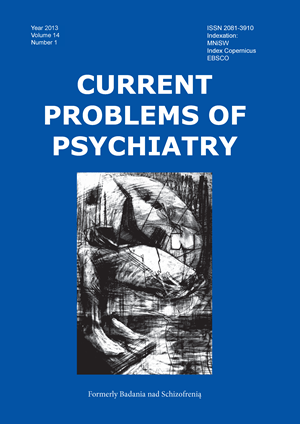Poziom niepokoju a cechy osobowości (obraz siebie i radzenie sobie ze stresem) u pacjentów z uszkodzonym stawem kolanowym
Słowa kluczowe:
niestabilność kolana, niewydolność czynnościowa kolana, dysfunkcje rzepkowo-udowe, obraz siebie, radzenie sobie ze stresem, niepokójAbstrakt
Celem pracy było określenie zależności między poziomem niepokoju a obrazem siebie i sposobami radzenia sobie ze stresem u osób z uszkodzonym stawem kolanowym oraz wyodrębnienie cech osobowości będących najlepszymi predyktorami niepokoju u pacjentów.
Materiał i metody: Badaniami objęto 32 pacjentów (15 kobiet i 17 mężczyzn), hospitalizowanych w NZOZ Arthros w Nałęczowie z powodu uszkodzeń stawów kolanowych. Średni wiek badanych wynosił 31 lat.
W pracy zastosowano następujące metody: Test Przymiotnikowy ACL, Gougha i Heilbruna, w wersji „jaki jesteś?”, Ankietę własnej konstrukcji, Arkusz Samopoznania R. Cattella oraz Kwestionariusz Radzenia Sobie ze Stresem w polskim opracowaniu Januszewskiej.
Wyniki: Stwierdzono istotne statystycznie zależności między wysokim poziomem niepokoju u pacjentów a negatywnym obrazem siebie oraz nieadaptacyjnymi, destrukcyjnymi sposobami radzenia sobie ze stresem. Na podstawie regresji liniowej krokowej wyodrębniono cechy osobowości najlepiej wyjaśniające poziom niepokoju u badanych osób.
Wnioski:
Poczucie znaczących zmian w życiu i pogorszenia jego jakości na skutek uszkodzenia stawu kolanowego u pacjentów współwystępuje z niedojrzałością osobowości, impulsywnością oraz nasilonym lękiem przed negatywną oceną ze strony innych osób.
Nasilony niepokój u pacjentów łączy się z cechami negatywnego obrazu siebie: trudnościami przystosowawczymi, brakiem autonomii, umiejętności radzenia sobie z zadaniami codziennego życia, lękiem przed nawiązywaniem relacji interpersonalnych, tendencją do ucieczki przed rzeczywistością w marzenia, niską tolerancją na frustrację, brakiem przedsiębiorczości, wytrwałości w realizacji zadań, brakiem pewności siebie i zaufania do siebie
Nasilony niepokój u pacjentów współwystępuje ze stosowaniem pasywnych sposobów radzenia sobie ze stresem: ucieczki przed problemami, izolowaniem się od ludzi, reagowaniem w sytuacjach trudnych długotrwałą koncentracją na poniesionych porażkach, rezygnacją z rozwiązywania zadań, obwinianiem siebie, agresją skierowaną w stosunku do innych ludzi lub do siebie oraz nadużywaniem alkoholu.
Bibliografia
1. Hunt P.A., Greaves I. Presentation, examination, investigation and early treatment of acute knee injuries. Trauma, 2004; 6: 53-66.
2. Nielsen A.B., Yde J. Epidemiology of acute knee injuries: a pro¬spective hospital investigation. J Trauma, 1991; 31: 1644-1648.
3. Yawn B.P., Amadio P., Harmsen W.S., Hill J., Ilstrup D., Gabriel S.Isolated acute knee injuries in the general population. J Trauma-Injury Infect Criti Care, 2000; 48(4): 716-723.
4. Januszewska E. Kwestionariusz Radzenia sobie ze stresem. Wartość diagnostyczna i wyniki badań młodzieży. W: Oleś P. red., Wybrane zagadnienia z psychologii klinicznej i osobowości. Metody diagnostyczne w badaniach dzieci i młodzieży. Lublin: Towarzystwo Naukowe KUL; 2005, s. 91-124.
5. Juros A., Oleś P. Struktura czynnikowa i skupieniowa Testu Przymiotnikowego ACL H.G. Gougha i A.B. Helbruna. W: Brzeziński J., Hornowska E. red., Z psychometrycznych problemów diagnostyki psychologicznej. Poznań: Wydawnictwo Naukowe UAM; 1993, s. 171-201.
6. Siek S. Wybrane metody badania osobowości. Warszawa: ATK; 1983.
7. Tarczyńska M., Potembska E., Dajewski Z., Gawęda K. Radzenie sobie ze stresem a ocena jakości życia u pacjentów z uszkodzonym stawem kolanowym. Curr Probl Psychiatry, 2012; 13(2): 115-122.
8. Tarczyńska M., Potembska E., Dajewski Z., Gawęda K. Obraz siebie a ocena jakości życia u pacjentów z uszkodzonym stawem kolanowym. Curr Probl Psychiatry, 2012; 13(2): 123-127.


